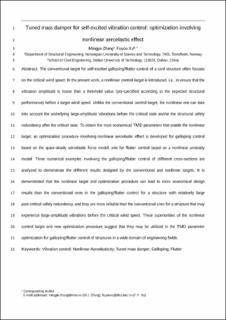| dc.contributor.author | Zhang, Mingjie | |
| dc.contributor.author | Xu, Fuyou | |
| dc.date.accessioned | 2021-11-23T12:06:45Z | |
| dc.date.available | 2021-11-23T12:06:45Z | |
| dc.date.created | 2021-11-19T19:49:54Z | |
| dc.date.issued | 2022 | |
| dc.identifier.issn | 0167-6105 | |
| dc.identifier.uri | https://hdl.handle.net/11250/2830992 | |
| dc.description.abstract | The conventional target for self-excited galloping/flutter control of a civil structure often focuses on the critical wind speed. In the present work, a nonlinear control target is introduced, i.e., to ensure that the vibration amplitude is lower than a threshold value (pre-specified according to the expected structural performance) before a target wind speed. Unlike the conventional control target, the nonlinear one can take into account the underlying large-amplitude vibrations before the critical state and/or the structural safety redundancy after the critical state. To obtain the most economical TMD parameters that enable the nonlinear target, an optimization procedure involving nonlinear aeroelastic effect is developed for galloping control based on the quasi-steady aeroelastic force model, and for flutter control based on a nonlinear unsteady model. Three numerical examples involving the galloping/flutter control of different cross-sections are analyzed to demonstrate the different results designed by the conventional and nonlinear targets. It is demonstrated that the nonlinear target and optimization procedure can lead to more economical design results than the conventional ones in the galloping/flutter control for a structure with relatively large post-critical safety redundancy, and they are more reliable than the conventional ones for a structure that may experience large-amplitude vibrations before the critical wind speed. These superiorities of the nonlinear control target and new optimization procedure suggest that they may be utilized in the TMD parameter optimization for galloping/flutter control of structures in a wide domain of engineering fields. | en_US |
| dc.language.iso | eng | en_US |
| dc.publisher | Elsevier | en_US |
| dc.rights | Attribution-NonCommercial-NoDerivatives 4.0 Internasjonal | * |
| dc.rights.uri | http://creativecommons.org/licenses/by-nc-nd/4.0/deed.no | * |
| dc.title | Tuned mass damper for self-excited vibration control: Optimization involving nonlinear aeroelastic effect | en_US |
| dc.type | Peer reviewed | en_US |
| dc.type | Journal article | en_US |
| dc.description.version | acceptedVersion | en_US |
| dc.source.journal | Journal of Wind Engineering and Industrial Aerodynamics | en_US |
| dc.identifier.doi | https://doi.org/10.1016/j.jweia.2021.104836 | |
| dc.identifier.cristin | 1956679 | |
| dc.description.localcode | This is the authors' accepted manuscript to an article published by Elsevier. Locked until 13.11.2023 due to copyright restrictions. The AAM is made available under the CC-BY-NC-ND 4.0 license http://creativecommons.org/licenses/by-nc-nd/4.0/ | en_US |
| cristin.ispublished | true | |
| cristin.fulltext | postprint | |
| cristin.qualitycode | 1 | |

